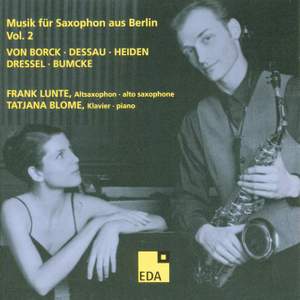The 1930s saw composers in Berlin beginning to use the saxophone as a classical instrument – the alto sax paired with the piano being a particular favorite. But alas, the heyday of the classical saxophone in Germany was all too short. The Nazis’ cultural policy was the kiss of death for this pariah instrument. Yet a good number of works for the concert saxophone still emerged in the face of this restrictive environment. Some appeared in Berlin, others were created in the exile that many composers had to choose after 1933. Only a handful of works for alto sax and piano were written in Germany after the war, and it wasn’t until the 1980s that this format finally enjoyed a rebirth. The four-part series “Music for Saxophone from Berlin / Music for Saxophone from Germany” offers a selection of works for this distinctive liaison of instruments – from pre-war Berlin, post-war Germany, and again from Berlin’s flourishing musical life at the turn of the millennium. Most of these are world-premiere recordings. The second CD in this series, “Music for Saxophone from Berlin Vol. 2,” connects right up to Vol.1, presenting works composed after the National Socialists had taken hold of the country. It highlights the hardships that the saxophone and the composers who used it had to bear under the new rulers’ restrictive cultural policy. As an instrument deemed “degenerate” (entartet), the saxophone was partly even prohibited during the Third Reich. Gustav Bumcke was dismissed from his teaching post at the conservatory, Erwin Dressel and Edmund von Borck were drafted into military service, and Paul Dessau and Bernhard Heiden fled from Nazi Germany. A group of hard-pressed composers, a stigmatized instrument, and a collection of striking works for alto saxophone and piano from 1934 to 1938, in which the spirit of resistance manifests itself by way of musical expression.



